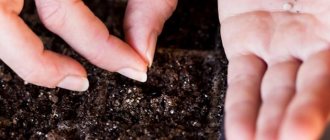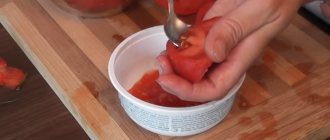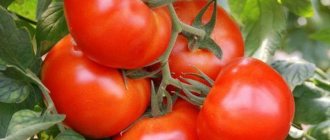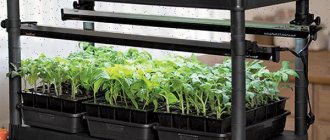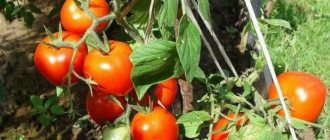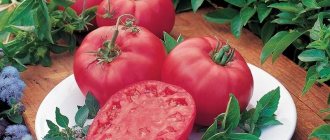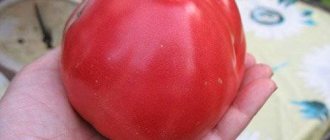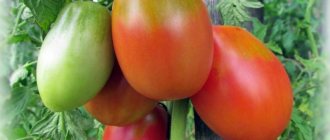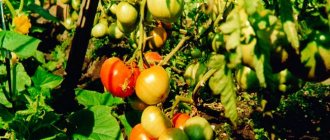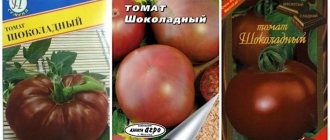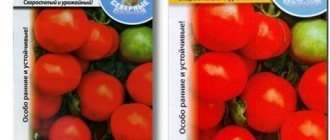Tomatoes: advantages and disadvantages
The variety has quite a lot of advantages:
- Green berries are able to ripen;
- Tomatoes are resistant to temperature changes;
- The bushes tolerate slight drought, but this may affect the harvest;
- The yield for these low bushes is quite good;
- Ability to be stored for long periods of time and transported without damage;
- Compactness of bushes;
- Early maturation;
- Disease resistance.
The disadvantages of the “Masterpiece Early” variety include only its demanding requirements for fertilizers.
Description and characteristics of the variety
Tomato Masterpiece F1 is a compact determinant with a lot of positive bonuses. Its bushes are characterized by the following features:
- stem height within 50 cm;
- 4-6 tomatoes are tied on fruitful clusters;
- leaves are dark green;
- foliage is moderate;
- 6-7 brushes are left.
The Masterpiece tomato is early and yields its harvest already in the first ten days of July – 90-96 days from germination.
Tomato Description:
- average weight 120-150 g;
- round and flattened shape;
- color bright red;
- the pulp is moderately juicy, tender, oily at the break;
- There are 4-5 seed chambers, the seed content is moderate.
The taste is traditional - a combination of delicate sourness with pleasant sweet notes.
Growing tomatoes
Any variety of tomatoes requires proper cultivation of seedlings and their further planting. And this process consists of several stages, discussed below.
How to prepare seeds?
The procedure for preparing seed material is not complicated, but it is important and the future harvest depends on it. After all, if you plant seeds that do not germinate, or material affected by fungal infections, this will directly affect the health and productivity of tomatoes.
The preparation includes the following procedures:
- Selection. Salt water will help sort through the seeds and determine which ones are empty (they will float to the surface);
- Treatment. Seeds can be collected from diseased bushes, especially if the seeds were bought at the market. In this case, disinfection is necessary. It can be carried out in a solution of potassium permanganate (1%);
IMPORTANT : You can also treat the seeds with bioactive substances, for example, aloe juice. This will increase the immunity and productivity of the bushes.
- Germination. To know for sure which seeds will sprout, you can pre-germinate them. To do this, place gauze in a shallow container, wet it and lay the seeds on top. In a few days, sprouts should appear from the seeds.
Sowing seed material
For sowing, prepare a shallow container and special soil. You can buy a mixture of soils in a store or mix the soil yourself from garden soil, sand and humus.
The landing algorithm is as follows:
- Furrows about 1 cm deep are made in the ground, and the distance between adjacent furrows should be at least 1.5 cm;
- Seed material is placed in the grooves;
- The seeds are crushed from above with earth without compacting;
- The container can be covered with film to create a greenhouse effect. The film will need to be removed after about three days.
HELP : It is important to place the container with seeds in a brightly lit place.
Before planting seedlings in a permanent place, you need to harden them. To do this, containers with sprouts are taken out onto the balcony or into the open air.
Rules for planting seedlings
The main thing when planting seedlings is to position the plants correctly. Holes in the ground are made at a distance of 40 cm from one another, and there should be at least 60 cm on the sides of each plant. After the seedlings are placed in the hole, the roots need to be buried in the ground.
Description and characteristics of tomato Masterpiece F1, reviews, photos
Late-ripening, indeterminate, large-fruited, productive tomato hybrid for greenhouses.
The bush is tall and requires reliable tying to a support and pinching. The best results were obtained when the plant was formed into 1 stem with the timely removal of all side shoots (stepchildren).
Basic qualities of fruits
The fruits are flat-round, large, red in color at maturity, weighing 300-600 grams (up to 1.3 kg), fleshy, excellent taste. Let these tomatoes ripen on the bush and you will understand that hybrids can be tasty. These tomatoes are good for fresh consumption and also for making juice.
It is advisable to sow seeds for seedlings 65-70 days before the intended planting in the ground. When planting seedlings in a permanent place per 1 sq. up to 4 plants are placed per meter of plot.
If you grew Masterpiece tomatoes, please write whether you liked them or not. Will you grow them again? Would you recommend them to others? Briefly describe the advantages and disadvantages of this tomato in your opinion. If possible, attach to the comment a photo of the entire bush as a whole or individual fruits that you grew. Thank you!
Your reviews of the Masterpiece tomato and additions to the description will help many gardeners evaluate this tomato more objectively and decide whether it is worth planting or not.
Diseases and pests
This variety has good immunity and is not particularly susceptible to various diseases. For example, tomatoes ripen earlier than the late blight epidemic begins, so there is no need to prevent this disease.
Prevention of different types of rot will help in the form of loosening the soil, removing weeds and mulching.
Pests that can live on tomatoes include:
- Aphid;
- Nematodes;
- Colorado beetles;
- Medvedki.
Pests are destroyed using special purchased products or folk methods.
HELP : Soapy water or a decoction of celandine can help against harmful insects.
Varieties of the Masterpiece tomato variety, its description and yield
Tomatoes have long occupied pride of place on the tables and beds of vegetable growers and consumers. Masterpiece tomatoes appeared thanks to the efforts of Russian breeders. Positive reviews have secured the tomato’s place among the sought-after plants for beginners and experienced gardeners.
General information about tomato
Today there are several types of Masterpiece tomato:
- An early masterpiece;
- Altai masterpiece;
- hybrid, masterpiece
The first one is preferably grown in temperate and warm climate zones. The plant is suitable for cultivation in open ground and greenhouses. General characteristics:
- mid-season variety, berry ripening time up to 120 days;
- high yield, up to 5 kilograms of berries per bush over the summer;
- short, height does not exceed 50 cm;
- medium foliage;
- leaves are small, dark green;
- the number of fruits in a brush is up to 6 pieces;
- resistance to many nightshade diseases;
- Long-term storage and transportation is possible.
The ripe berry has a sweet taste and an average weight of 120 grams. It is among the universal ones for use. Suitable for canning, pickling and fresh consumption.
The Altai species is also mid-season. Distinctive features include:
- tall, bush height up to 2 meters;
- cold-resistant;
- high yield, up to 4 kilograms per bush;
- resistance to most diseases;
- simple inflorescences;
- tolerates weather changes well;
- large-fruited, weight of individual berries up to 500 grams.
The variety belongs to the salad species. Ripe berries make an excellent ingredient for vegetable salads and tomato products: juices, pastes, sauces.
The third species, Masterpiece f1, belongs to the late-ripening varieties; in all other characteristics it is similar to the Altai species.
Features of agricultural technology
All varieties of Masterpiece tomatoes prefer the seedling method of planting. You can get healthy seedlings by following a number of rules:
- plant seeds to a depth of 1.5-2 cm;
- after sowing, cover containers with seedlings with film;
- when the first shoots appear, move the plants to a windowsill or to a source of artificial lighting;
- regular watering.
IMPORTANT! Before planting, seedlings must be hardened off. The agricultural technology features of the Masterpiece variety of tomatoes have a number of general rules:
The agricultural technology features of the Masterpiece variety of tomatoes have a number of general rules:
- watering with warm, settled water in the evening or morning as needed;
- fertilizing the soil with complex mineral fertilizer at least 4 times per season;
- loosening the soil;
- regular weeding.
For a low-growing species, experienced gardeners advise installing supports under the branches to obtain a better harvest.
Gardeners' opinions
Good day to all! For residents of the northern regions, I recommend the Masterpiece tomato variety. The plant tolerates cold and extreme weather conditions well. The tomato shows resistance to a large number of nightshade diseases and is unpretentious in care. I didn’t find any cons for myself.
Valentin Yagodkin, 43 years old.
I discovered the Altai Masterpiece tomato. The variety is very persistent and not capricious. Gives a decent harvest in cool, rainy summer conditions. The berry is large, sweet and juicy. An excellent option for salads and pickles.
Arkady Novoselov, 47 years old.
Disease and pest control
The Altai masterpiece is resistant to fungal diseases. Good immunity allows plants to cope with infection on their own, but if care rules are violated, pathogenic microorganisms can begin to develop on the bushes.
Late blight, a disease that affects bushes, poses a danger to the health of the crop. The infection develops rapidly, spreading from leaves and stems to fruits. As a result, tomatoes develop poorly, become stained, wither and become unfit for consumption.
The cause of root rot (another common disease) is a violation of the watering regime. The roots of the plants begin to rot, fungal spores appear in them, and the bushes die.
- Water plants only with warm water.
- Strengthen plants with mineral fertilizers.
- Remove damaged and diseased shoots in a timely manner.
- Make sure that the soil does not rot.
This variety does not suffer from pest attacks. Despite this, periodically inspect the seedlings for the presence of caterpillar larvae and aphids.
Tatyana Orlova (Vasilidchenko) (candidate of agricultural sciences):
There are tomato varieties that are immune to certain diseases, but there are no tomato varieties that are immune to pests. All of them are damaged by the main insect pests of tomatoes.
